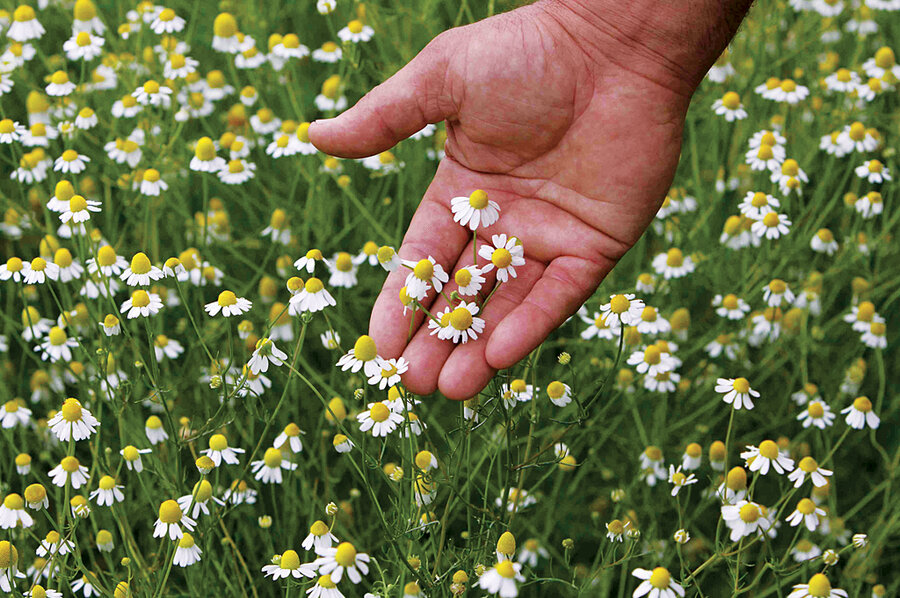A garden grows with abandon
Loading...
"My husband would hate your garden," Amy observed, looking around at what I have to admit was a rather unruly collection of plants in various stages of growth, production, and decline.
Amy's a caterer. Occasionally she comes to see if there is anything new that she wants to grow in the well-ordered rectangle she and her husband, Sean, cultivate behind their house. That day, she was picking raspberries in the patch of canes that have migrated into my vegetable garden. Actually it's not so much a vegetable garden as a vegetable, herb, flower, and now fruit garden. That's what Sean would hate. That, and the ecumenical mix – or unholy jumble, depending on your point of view – of all those things together.
Sean prefers regimented lines of peas, beets, lettuce, peppers, and beans. His fondness for unadulterated rows has been reinforced by Amy's family, farmers who produce corn, soybeans, and wheat in the fields that surround our small town. Their work is mechanized; anything that doesn't conform to the pervasive vast blanket in a field is a weed and gets hacked beneath the blades of the cultivator. A patchwork like mine would be impossible to deal with. Besides, it's untidy.
While I understand the farmer's need to banish weeds (defined as any plant out of place, including corn plants that volunteer from last year's crop in this year's monoculture fields of wheat or soybeans), I don't consider everything that springs up unbidden to be a weed.
Compact wild camomile is welcome, a bright swatch of white daisy faces that highlight the green leaves of a San Marzano tomato or adorn the shoulder of a red cabbage like a wildflower corsage. Annual herbs that have broadcast seeds the previous fall are just as useful in the little squares they've chosen as they were in places I chose for them. Sometimes more so. The dill that appeared beside the cucumbers last year not only flavored chilled tomato soup and grilled salmon, it also served as host plant to caterpillars that morphed into several colorful species of swallowtail butterflies. The cilantro that stitched itself through the Italian bush beans made weeding them rather challenging, but turned out to be the only cilantro in the garden. What I had carefully sown didn't grow.
The Magic Evening primroses, which spread themselves all over the vegetable garden each year, are not weeds, either. They are unplanned but much-loved additions. Each evening at twilight, they burst open a new set of luminous yellow blooms, like floral fireworks.
We go out after supper, alone or with friends, to enjoy the show. The blossoms also draw pollinators. In the evening, it's hummingbird moths, who are so intent on their mission that they sometimes graze us with gossamer wings as they dart through the flowers. In the morning, it's hummingbirds, who drink the dregs of the previous night's round of blooms. More curious than the moths, they occasionally hover at eye level, studying me as I sip my morning coffee.
Of course there are actual weeds, too: mare's-tail, lamb's-quarters, henbit, dock, bindweed. Some are edible, some are pretty, and some are the bane of my gardening life. I concentrate on the worst offenders and ignore the others.
From a farmer's perspective, my garden may be spectacularly untidy. From mine, too, actually. I like tidy, but it doesn't dovetail with my vision for this particular botanical canvas. Here, I want something more like an evolving Impressionist painting – imprecise, slightly unpredictable, and a little smudged and frayed, but richly rewarding for the effort and love involved in its making.
Straightening up with a half-filled bowl of raspberries tucked into the crook of an arm, Amy looked around the garden again.
"Sean would hate this," she repeated, grinning. "But I love it. It's whimsical. Everywhere you look, there's something different." Exactly. Each year, it's something new, a visual reminder of the amazing variety of life itself. I plan, plant, and cultivate new varieties of edibles. But each year I also wait to see what unforeseen additions nature has made to my patchwork garden.





